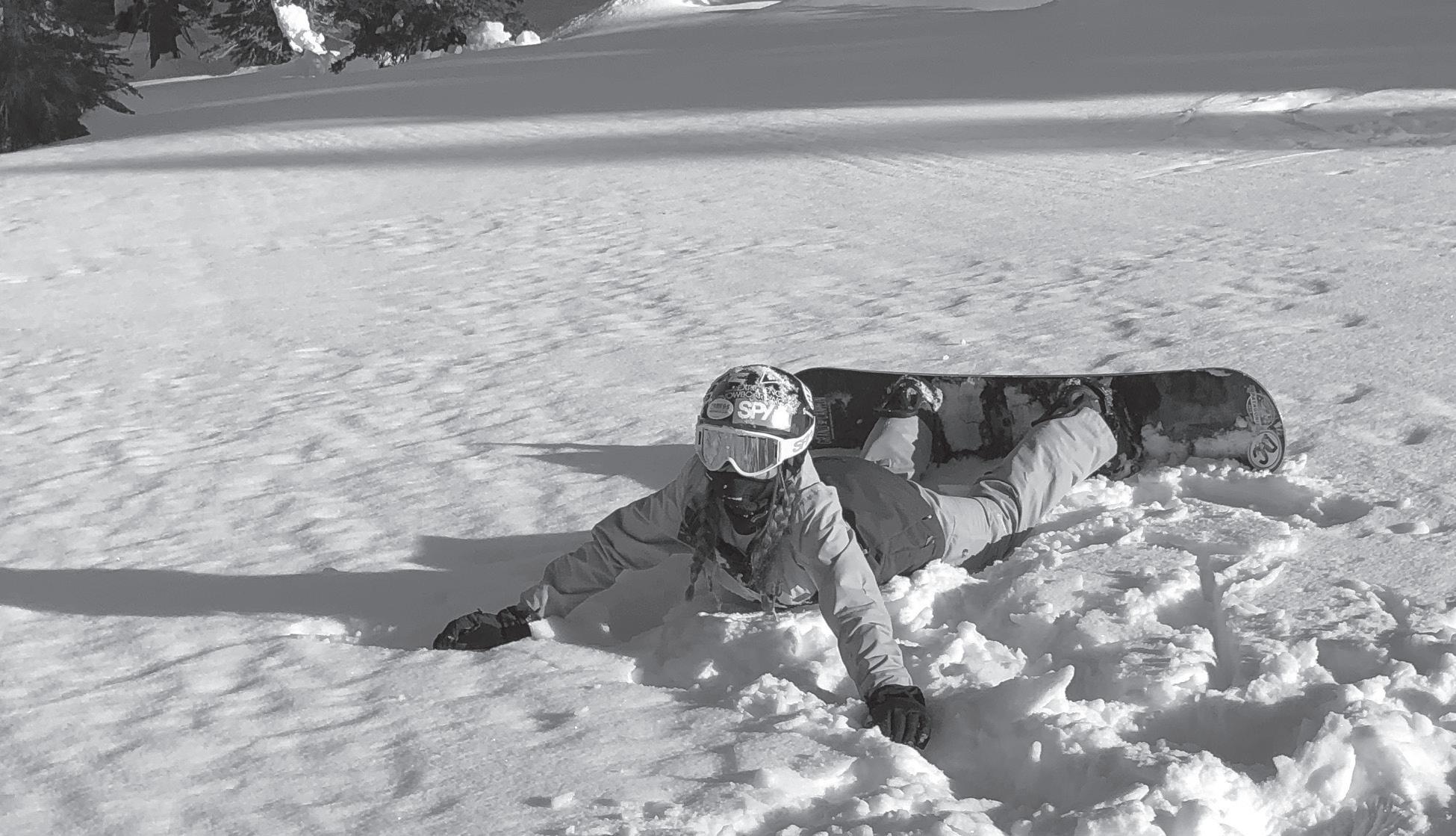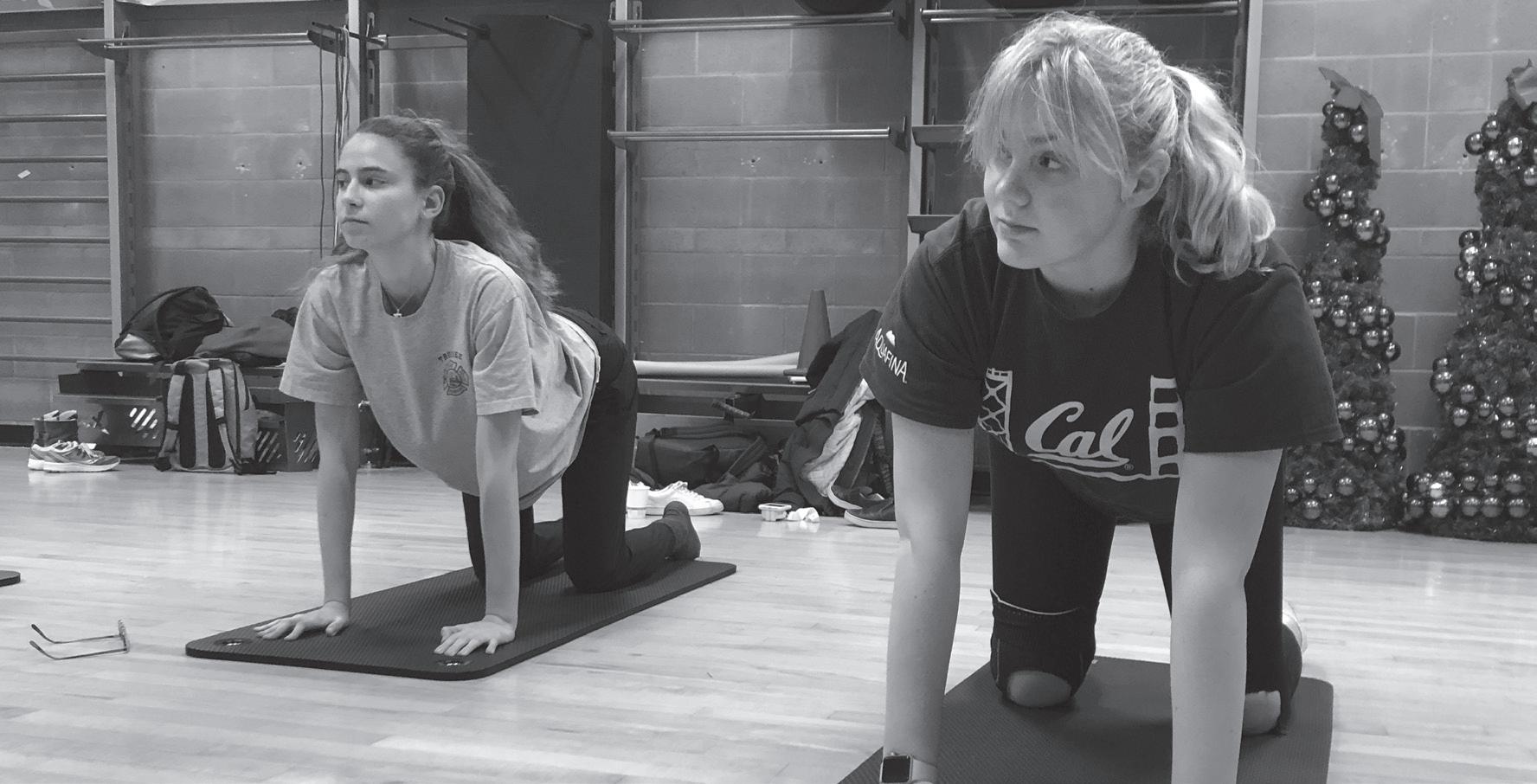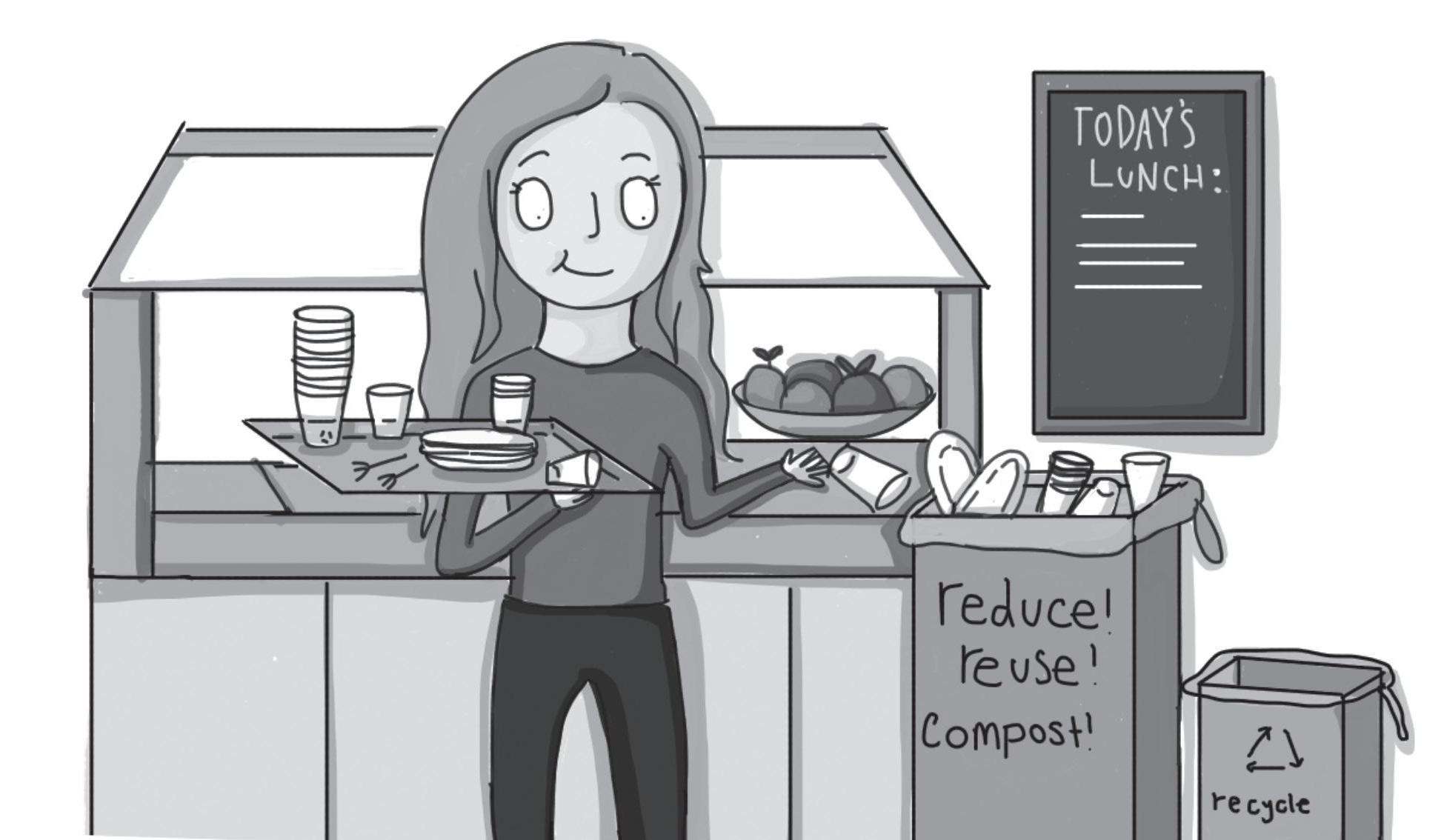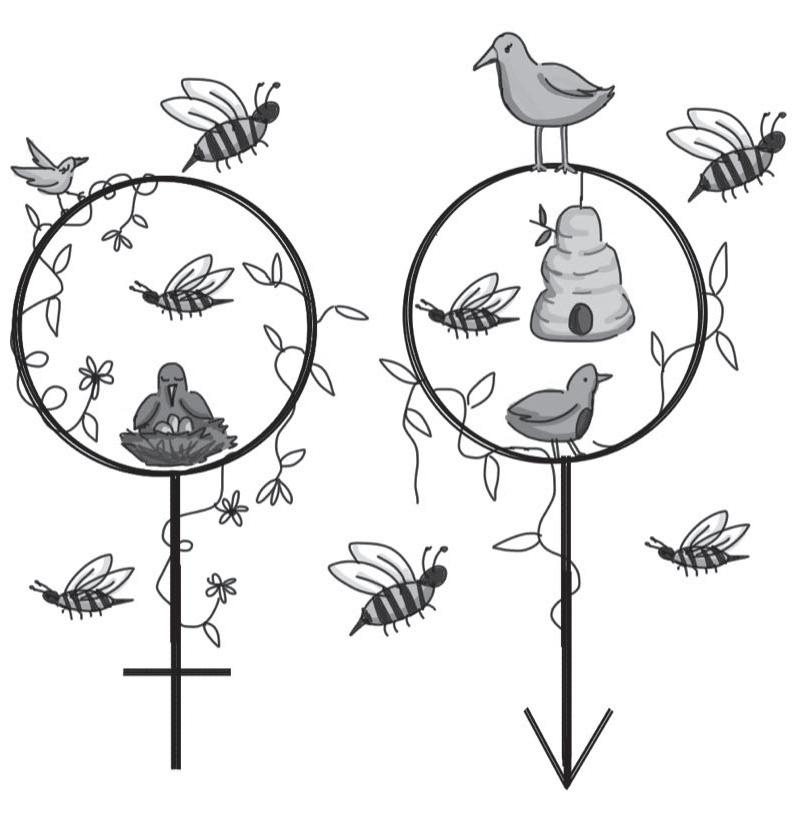
20 minute read
swim yoga
Speeding down the slopes
Winter Break provides opportunity to learn snowboarding
Advertisement
Stretch before you stroke Olivia Rounsaville
Senior Reporter M any students are pulling out their goggles, helmets, boots and snowboards in preparation for a popular winter activity over next week’s Winter Break — snowboarding.
“One day my parents suggested either taking a snowboarding lesson or a ski lesson,” junior Audrey Hunnicutt said. “I loved watching snowboarding in the Olympics so I decided to choose snowboarding even though all my friends liked to ski, hoping to stand out a little and not do something solely for the reason that my friends did it.”
While students like Hunnicutt snowboard competitively, others like sophomores Mia Sassi and Takhoui Asdorian snowboard recreationally at resorts in Tahoe.
“My dad taught me snowboarding when I was little and I’ve just been doing it ever since,” Asdorian said. “I love the excitement of going down the mountain and it’s something special my dad and I can bond over.”
Sassi, who had skied since she was 5, recently decided to switch to snowboarding because snowboarding gives her more freedom to get down the slopes.
“I really enjoy the thrill of snowboarding,” Sassi said. “I had been skiing for so long, and it got boring for me because it became repetitive after a while.”
Hunnicutt was a member of the Northstar Competition Snowboard team for three years at the ski and snowboard resort in Lake Tahoe. The team is a part of the United States Ski and Snowboard Association which participates in competitions in
Swimmers do preseason yoga
Mackenna Moslander
Reporter B efore spring sports begin and swimmers dive into the pool for the first practice of the season, the swim team is participating in preseason Kundalini yoga sessions to work on breathing and muscle strength.
Yoga can help with many skills including core strength and endurance, which are necessary for every athlete, according to head swim coach Cassandra Esparza.
“I have coached soccer, swimming and volleyball at Convent, and I do yoga with every team,” Esparza said. “I try my best to integrate it into every team I coach.”
The yoga classes involve poses with stretching and breathing and a distinct aspect of Kundalini is the incorporation of breathing mantras into each pose. The exercises can be especially helpful when it comes to flexibility and endurance, according to sophomore Madison Kwan.
“Yoga is all about making sure your limbs and joints are really flexible,” Kwan said. “This is really important to swimming because the more extension you have, the better your technique gets.”
While the yoga classes include poses, stretches and breathing exercises, they also build a strong mindset, which is an important trait for all athletes, according to Esparza.
“My training as an athlete started with yoga when I was four,” Esparza said. “It not only gave me strength, but it also gave me self-confidence and the belief that I was able to do more physically than I thought I was capable of.”
The yoga class includes a variety of breathing exercises, such as “breath of fire” — successive inhales and exhales through the nose — and “lion breathing” — open mouth breaths with a stretched out tongue and a loud “hung” sound originating from the throat on the exhale.
Yoga is beneficial to expanding lung capacity, which is helpful for swimmers, who need to have breath control, according to junior Izzy Ritchie.
“Coach Cazz does a lot of useful breathing exercises,” Ritchie said. “It helps us maintain our breath control and helps our lung capacity in general.”
Kundalini yoga is a physical workout that has an emphasis on meditation. This preseason training is especially enjoyable because it is calming and the team gets to spend time together outside of the pool, according to Kwan.
“The whole experience is really peaceful,” Kwan said. “I feel very centered after, and I get to spend time with my teammates before the season even starts.”
Yoga can also assist in the rehabilitation of muscles and injuries with each pose addressing a specific muscle and strengthens the surrounding musculature. Esparza is especially acquainted with the rehabilitation aspect of yoga, having qualified for the 1996 Olympics, in both freestyle and breaststroke, but a car accident cut short her career. Yoga was the rehabilitation method she says helped her the most.
“After my accident, yoga was pretty much my rehabilitation for everything both physical and physiological,” Esparza said.
Monty Buesnel | WITH PERMISSION SNOW DAY Sophomore Takouhi Asdorian takes a break from a day of snowboarding at Alpine Meadows Ski Resort. Tahoe-area ski resorts offer equipment rentals and lessons in addition to lift passes. Tahoe and across the country.
“Snowboarding is a challenging endeavor,” Hunnicutt’s snowboarding coach Nancy Brest said. “Snowboarders must learn their limitations and what they need to work on.”
Snowboarding competitions include a variety of events, including slopestyle, halfpipe and rail jam. Competitions can also include less serious races such as bank phone or skolf, a cross between golf and snowboarding.
“Competitions can be stressful,” Hunnicutt said, “but they are also a great way to improve and learn from everyone there and get to know more people from the Tahoe area and the Bay Area.”
Major Tahoe resorts including Squaw, Sugar Bowl and Mt. Rose have snowboarding teams that are open to kids ranging from around 7 to 18 depending on the team and those interested in joining a team can visit resort websites or contact coaches for more information.
“Joining a snowboarding team is a big commitment,” Sassi said. “I would prefer to just snowboard for fun when my family travels to the snow.”
Sports Basement sells lift tickets for Sugar Bowl, Diamond Peak, Sierra at Tahoe, Squaw Valley and Alpine Meadows and Homewood Mountain Resort ranging from $34 to $75. Most resorts offer snowboarding lessons which average at $130 for a two-hour lesson.
Mackenna Moslander | THE BROADVIEW STRETCH YOURSELF Senior Arlena Jackson and freshman Samantha Calvin move into cow pose in the yoga sequence "cat and cow." Preseason swim team yoga sessions took place in the workout room located next to Herbert Center and may be added to dryland practices.

ON YOUR MARK Acting out of bounds

Adele Bonomi Sports Editor
Mourners overlook accusations
Legends may never die but, in this case, interest in a sexual assault lawsuit certainly did.
When Kobe Bryant, the Los Angeles Lakers star player and National Basketball Association icon, died on Jan. 26 in a helicopter crash with eight others, including his 13-yearold daughter Gianna, fans paid tribute to mourn his death by gathering in the streets of Los Angeles and by reposting images of him and his daughter on social media.
While many fans celebrated Bryant’s accomplishments, including his five NBA championships, 18 All-Star games and two Olympic gold medals, there was little mention of his trial for sexual assault in 2003. A 19-year-old hotel employee accused Bryant of raping her in his hotel room, but Bryant told the police that they had consensual sex. Throughout the trial, Bryant’s wife Vanessa stood by his side.
The case was dropped because the woman refused to testify. Bryant posted a long statement apologizing to the woman, acknowledging that his perspective differed from hers.
The alleged rape needs to be included in the story of Bryant’s life for fans to understand that no one, not even NBA icons are perfect.
Since retiring from the NBA, Bryant focused on supporting women’s athletics, frequently highlighting the Women’s National Basketball Association and recording voice overs for the NCAA women’s basketball team.
Powerful men are rarely held accountable for their misdeeds. We focus on their accomplishments and not on their mistakes.
Yet, Bryant’s actions over the next 16 years — apologizing and taking time to acknowledge women in sports, including supporting his daughter Gianna Bryant’s basketball team, and taking pride in being a #girldad — demonstrates that one’s past does not always define who someone is now.
As we remember Bryant, we need to look beyond losing an icon and instead recognize that he was a flawed man who earned redemption.
Reducing, reusing — but not recycling

Labeling products as “biodegradable” or “compostable” is a great marketing tool for brands trying to avoid public scrutiny, but ecofriendly consumers choosing to buy these products may be giving the environment the short end of the stick.
Most single-use, plastic cups labeled compostable and found in the school cafeteria or in restaurants are made of PLA plastic that is marketed as biodegradable, but it can only be industrially composted, according to the Student Environmental Resource Center at the University of California Berkeley.
These plastics can take anywhere from 30 to 90 days to decompose in ideal conditions, and for composting facilities running on short cycles, they simply take up too much space.
These plastics often end up in landfills, which resemble vacuum chambers with no oxygen, and decompose anaerobically, producing methane gas as opposed to carbon-dioxide — which is worse for the environment.
Just because something is “plant-based” does not mean it is a safe and green choice. Companies who use these labels are trying to appeal to eco-friendly customers looking for simple solutions instead of choosing reusable items instead of singleuse products that are hard to compost.
Even if these products end up in the compost bin, most commercial compost facilities have a policy against commercial dishware such as PLA plastic cups or compostable utensils and will send them to landfill, according to Live Science.
Recology San Francisco will only compost plastics specifically labeled as compostable. Biodegradable plastics are placed into landfill.
It should not take rocket science to be an environmentally-conscious shopper, but the complexity of single-use compostable items might mean that shopping may not solve this ethical dilemma.
In the biodegradable frenzy that has followed the climate justice movement, consumers have forgotten the original environmentally-friendly slogan: reduce, reuse, recycle.
Products labeled as plantbased are popular because they allow consumers to be lazy and experience the convenience of single-use products while still feeling as though they are making a difference.
The assumption is that because the products are compostable, they have little to no impact on the environment, which is not quite accurate.
Assuming these biodegradable plastics actually end up in the compost, PLA plastic takes six months to decompose, according to TrueChoicePack Corp, a manufacturer of disposable products.
Consumers can make the kindest choice for the environment by reducing consumption of plastic all together. Although it may be less convenient to bring a coffee mug to school or a coffee shop instead of using a single-use cup, behavioral changes like this can have a big impact on an individual’s environmental footprint.
The only way to make a difference as part of the climate justice movement is to make it clear that this change is a priority and to minimize the demand of supply. It should start with change in our own habits, as well as with our school cafeteria.
The Broadway Campus currently cafeteria uses single use plates, cups and utensils, and only elementary school students eat from reusable trays because of the lack of dishwashing equipment.
While adding the equipment and reusable dishware seems to be a future goal for the school, there is no immediate plan to make this happen.
Allocating resources to add adequate dishwashing facilities in the near future would not only reduce our school’s carbon footprint, but it also sends a message of what our priorities are.
Until then, using reusable containers and utensils is the best way to spark change. choice for the environment by reducing consumption of plastic all together. Although it may be less convenient to bring a coffee mug to school or a coffee shop instead of using a single-use cup, behavioral changes like this can have a big impact on an individual’s environmental footprint.
The only way to make a difference as part of the climate justice movement is to make it clear that this change is a priority and to minimize the demand of supply. It should start with change in our own habits, as well as with our school cafeteria.
The Broadway Campus currently cafeteria uses single use plates, cups and utensils, and only elementary school students eat from reusable trays because of the lack of dishwashing equipment.
While adding the equipment and reusable dishware seems to be a future goal for the school, there is no immediate plan to make this happen.
Allocating resources to add adequate dishwashing facilities in the near future would not only reduce our school’s carbon footprint, but it also sends a message of what our priorities are.
Until then, using reusable containers and utensils is the best way to spark change. Buying reusable items are a better option to compostable plastic Marisa Donovan | THE BROADVIEW
VULAKH'S VIEW
The real presidential election takes place six weeks after the first Tuesday in November, when 538 presidential electors in Washington, D.C., cast their ballots.
In 48 states and the District of Columbia, the candidate who wins the popular vote receives all of the Electoral College votes for that state, however, after the Supreme Court hears a case from Washington and another from Colorado in the spring, electors may have the right to vote for the candidate of their choosing, regardless of whether their choice corresponds to the outcome of their state’s popular vote.
The founding fathers created the Electoral College in the end of the 18th century to give smaller rural communities in middle America the same representation as coastal larger industrial cities, giving every state — regardless of population — at least three electoral votes.
The Electoral College system is now unequal and outdated. With a population of 577,737 people and three electoral votes, Wyoming gets one vote per 192,579 citizens, while California with a population of 39.56 million people and 55 electoral votes, gets one vote per 700,000 plus citizens.
Looking toward the November presidential election, voters should be reconsidering the weight of their individual vote after the 2016 election in which the nominee who won the popular vote lost the presidency.
Hillary Clinton won approximately 65.9 million popular votes to Donald Trump’s 63 million votes in 2016, however Trump won the Electoral College by 74 electoral votes, making him President of the United States.
In four other presidential elections — 2000, 1888, 1876 and 1824 — the elected president lost the popular vote, and the Electoral College system was the deciding factor in who won the American presidency.
The Electoral College makes voters, especially those in highly populated states with a consistent voting demographic, feel as if their votes do not count. This is a serious problem, as it disengages potential voters and sets the precedent that voters in these states do not have a say in presidential elections.
Every other American election, whether it be for senator, mayor or city council is elected through the popular vote. When electing the leader of a country, every individual’s vote should count the same as in a smaller election. Voters should not have to rely on others in their state to vote along the same party lines.
When a presidential candidate receives the most popular votes across the nation, that is a clear message that the country feels best represented by this candidate.
Five presidential elections would have ended differently if each citizen’s vote truly counted. Hopefully the 2020 election will not add to the list. Every vote counts Gabriella Vulakh Editor-in-Chief
1. Heavy rain in Australia has put out some wildfires that have been burning for months.
2. Virginia is considering banning LGBT discrimination in housing and employment.

3. Part of Market Street has banned private vehicles to encourage biking and public transportation.
4. Singer Taylor Swift released a documentary about her life and work with politics. 1. Flooding resulting from rain and burned cover has forced evacuation.
2. No Southern state has this ban.
3. Market has averaged over 100 pedestrian or bicycle accidents a year in the past five years.
4. Swift received backlash when she became politically active.
OP-ED The Broadview T he Netflix series “Sex Education” follows Otis, an awkward teenager, who, despite being a virgin, opens a sex clinic because his mom is a sex therapist. The queries Otis answers, including whether or not chlamydia is an airborne disease, show that Otis’ school does not teach sex education, a problem that extends beyond this fictional school.
Movies and TV shows often portray sex education programs stressing abstinence or missinforming students, such as Coach Carr, the health teacher in “Mean Girls,” who warns his students, “Don’t have sex because you will get pregnant and die.”
While the Mean Girls scene is clearly a satire on the poor quality of sex education at many schools, students who have never been formally educated at school or by their parents may only learn about sex from the media.
Forty one percent of high schoolers in the United States are sexually active, according to Planned Parenthood, yet private schools in California are not mandated to teach sexual education.
While it can be debated how successfully this is implemented by each school, California public schools are mandated to teach sex education, be medically accurate, include information on contraception and abstinence and to be sexual orientation inclusive.
As more than a third of 15 year old girls are sexually active, according to Planned Parenthood, a comprehensive sex education is critical for all students starting in freshman year.
The average teenager sees more than 15,000 references to sex on TV alone each year and more than half of teenagers using the internet have been exposed to porn within the last year, according to “Time” magazine, yet 83% of female teenagers do not have formal sex education before their first time having sex, according to the Center for Disease Control and Prevention.
With constant exposure in the media, sex is not a secret to teenagers, but what teens learn in the media is often not adequate and can be misinforming.
Schools need to supplement sex education for all students in order to keep them safe and informed on healthy relationships, safe sexual practice, disease prevention and consent.
Convent has offered spaces to talk about sex and sexuality, such as opportunities to ask anonymous questions to health professionals and assemblies on consent and rape, but students should not have to piece together information from occasional meeting spaces. An extensive sex education program is necessary to educate, protect and prepare students.
Eighty two percent of parents have talked to their children about sexuality related topics, but these conversations are often not enough, as parents do not have the same qualifications and information as health professionals.
Of the parents who do talk to their children about sex, only Let’s talk about sex Gray Timberlake
Editor-in-Chief Schools should require health classes for students
60% talk about birth control and 74% talk about ways to say no to sex, according to a Planned Parenthood survey, indicating not all parental talks are adequate.
A complete sex education program includes age-appropriate and medically accurate information and goes beyond biological aspects to include

human development, relationships, abstinence, contraception and disease prevention, according to the Sexuality Information and Education Council of the United States.
All teenagers need a comprehensive sex education, and there is no better place to educate than at school. Marisa Donovan | THE BROADVIEW
IS IT IMPORTANT FOR SCHOOLS TO TEACH SEX ED?
“It’s important to have, even if sex ed is an uncomfortable subject.” — Chiara Hertsgaard, freshman
“Its important for everyone to be educated so that people can be safe.” — Maddie Drda, sophomore
Convent of the Sacred Heart High School 2222 Broadway St. | San Francisco, California 94115 broadview@sacredsf.org | broadview.sacredsf.org
thebroadview @thebroadview thebroadviewsf thebroadview @thebroadview
STAFF Gray Timberlake Editor-in-Chief Gabriella Vulakh Editor-in-Chief Tracy Anne Sena, CJE Adviser
“Schools of the Sacred Heart commit themselves to educate to personal growth in an atmosphere of wise freedom,” (Goal 5), therefore The Broadview operates as an open forum for free speech and student expression without prior review. Unsigned pieces are the opinion of the editorial board. Reviews and personal columns are the opinions of the individual author and are not necessarily those of Convent of the Sacred Heart High School or Schools of the Sacred Heart. We encourage letters to the editor. The Broadview may publish independent opinion pieces 300 words or fewer. The editors may work with writers for clarity and to meet space limitations. All letters must have a means for verifying authorship before publication. Corrections and letters may be addressed to the editors at broadview@sacredsf.org 2020 CSPA Crown Recipient 2019 NSPA Pacemaker Finalist 2019 JEA First Amendment Press
Freedom Award 2019 CSPA Gold Crown 2018 CSPA Silver Crown 2018 JEA/NSPA First Amendment Press Freedom Award 2018 NSPA Print Best of Show, 3rd place 2018 NSPA Pacemaker Finalist 2017 JEA/NSPA First Amendment Press Freedom Award 2017 NSPA Online Pacemaker 2016 Print NSPA Pacemaker 2016 Online NSPA Pacemaker NSPA Hall of Fame | Inducted 2016 Charlotte Ehrlich Web Editor Grace Krumplitsch Web Editor Caroline Thompson Copy Editor
Madeline Thiara
Components Editor Adele Bonomi Sports Editor Cat Webb-Purkis Art Editor
Senior Reporters Gabrielle Guido, Tabitha Parent, Olivia Rounsaville
Reporters Adele Fratesi, Mackenna Moslander,
Paige Retajczyk, Alina Kushner, Elise Vulakh Marisa Donovan Cartoonist
“Without sex ed, people might be misinformed due to unreliable sources." — Catherine Baker, junior
“We should have it so people can make better choices for themselves.” — Audrey Pinard, junior
“I don’t think we should have sex ed because I think it’s the parents’ job to educate their kids.” — Arlena Jackson, senior
GRAY AREA
Next month I turn 18, making me a legal adult who can vote, get married, sue, enter contracts and buy property, but — unlike my classmates at Stuart Hall — I am not required to register for the Selective Service.
An independent government agency, the Selective Service registers men for potential drafts, when authorized by both Congress and the president. The Selective Service Law currently reads that “all male citizens, regardless of where they live, and male immigrants, whether documented or undocumented, residing in the United States, who are 18 through 25, are required to register with Selective Service.”
The Selective Service was discontinued in 1975 by a presidential proclamation by President Gerald Ford, but President Jimmy Carter reinstated it because of fears of foreign tension and suggested that Congress amend the Act, requiring women to register. While Congress approved reinstating the Selective Service process, the funds allocated were only sufficient to draft men.
While the inequality in the Selective Service may not be a pressing issue for feminists because of its seeming irrelevancy, it stands as one of the last legal acts separating women and men.
The National Coalition for Men, a civil rights organization that addresses how sex discrimination effects men, sued the Selective Service in 2019, claiming women being excluded from the draft was unconstitutional. The resulting report, due next month, will either make registering voluntary for both males and females, mandatory for both or eliminate the draft altogether.
While all of these potential solutions will lead to legal equality, legal equality will not lead to social equality between men and women.
First wave feminists in the United States fought for legal equality, especially the right to vote, in the 19th and 20th centuries. When it comes to laws with higher stakes than voting — like being drafted — feminists are less likely to fight for equality.
After tension between the United States and Iran worsened in January, memes and TikToks about the so-called “World War III” went viral. Among these memes were women joking that they previously were feminists, but would go back to the constricting gender norms of presuffrage United States if it meant they would not have to be drafted in “World War III.”
One meme was a stock image of three pregnant women with the caption “me and my girls when we hear that women might get drafted to #ww111.” Another tweet read “*World War 3 is announced* Feminists: Back in the kitchen.”
While meant to be comical, the memes illustrate that many feminists are willing to put in the work for issues of equality regarding the historical oppression of women’s rights. Inequality in the Selective Service does not feel oppressive to women and women are unlikely to fight for a change in the system, as women get an “out” in the case of a draft.
I do not want to register for the Selective Service and risk getting drafted, but all women, myself included, need to “man up” — even when it’s inconvenient — if they want equal rights. All mighty means all Gray Timberlake Editor-in-Chief


